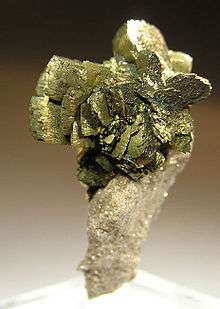Marcasite
| Marcasite | |
|---|---|
|
Marcasite with tarnish (8x6 cm) | |
| General | |
| Category | Sulfide mineral |
| Formula (repeating unit) | FeS2 |
| Strunz classification | 02.EB.10a |
| Crystal system | Orthorhombic, Pnnm |
| Space group | Orthorhombic 2/m 2/m 2/m |
| Unit cell | a = 4.436 Å, b = 5.414 Å, c = 3.381 Å; Z = 2 |
| Identification | |
| Formula mass | 119.98 |
| Color | Tin-white on fresh surface, pale bronze-yellow, darkening on exposure, iridescent tarnish |
| Crystal habit |
Crystals typically tabular on {010}, curved faces common; stalactitic, reniform, massive; cockscomb and spearhead shapes due to twinning on {101}. |
| Twinning | Common and repeated on {101}; less common on {011}. |
| Cleavage | Cleavage: {101}, rather distinct; {110} in traces |
| Fracture | Irregular/Uneven |
| Tenacity | Brittle |
| Mohs scale hardness | 6-6.5 |
| Luster | Metallic |
| Streak | Dark-grey to black. |
| Diaphaneity | Opaque |
| Specific gravity | 4.875 calculated, 4.887 measured |
| Pleochroism | [100] creamy white; [010] light yellowish white; [001] white with rose-brown tint. Anisotropism: Very strong, yellow through pale green to dark green |
| References | [1][2][3] |
The mineral marcasite, sometimes called white iron pyrite, is iron sulfide (FeS2) with orthorhombic crystal structure. It is physically and crystallographically distinct from pyrite, which is iron sulfide with cubic crystal structure. Both structures do have in common that they contain the disulfide S22− ion having a short bonding distance between the sulfur atoms. The structures differ in how these di-anions are arranged around the Fe2+ cations. Marcasite is lighter and more brittle than pyrite. Specimens of marcasite often crumble and break up due to the unstable crystal structure.
On fresh surfaces it is pale yellow to almost white and has a bright metallic luster. It tarnishes to a yellowish or brownish color and gives a black streak. It is a brittle material that cannot be scratched with a knife. The thin, flat, tabular crystals, when joined in groups, are called "cockscombs."
In marcasite jewellery, pyrite used as a gemstone is termed "marcasite" – that is, marcasite jewellery is made from pyrite, not from the mineral marcasite. In the late medieval and early modern eras the word "marcasite" meant both pyrite and the mineral marcasite (and iron sulfides in general).[4] The narrower, modern scientific definition for marcasite as orthorhombic iron sulfide dates from 1845.[2] The jewellery sense for the word pre-dates this 1845 scientific redefinition. Marcasite in the scientific sense is not used as a gem due to its brittleness.
Occurrence


Marcasite can be formed as both a primary or a secondary mineral. It typically forms under low-temperature highly acidic conditions. It occurs in sedimentary rocks (shales, limestones and low grade coals) as well as in low temperature hydrothermal veins. Commonly associated minerals include pyrite, pyrrhotite, galena, sphalerite, fluorite, dolomite and calcite.[1]
As a primary mineral it forms nodules, concretions and crystals in a variety of sedimentary rock, such as in the chalk layers found on both sides of the English Channel at Dover, Kent, England and at Cap Blanc Nez, Pas De Calais, France, where it forms as sharp individual crystals and crystal groups, and nodules (similar to those shown here).
As a secondary mineral it forms by chemical alteration of a primary mineral such as pyrrhotite or chalcopyrite.
Varieties and blends
Blueite (S.H.Emmons): Nickel variety of marcasite, found in Denison Drury and Townships, Sudbury Dist., Ontario, Canada.
Lonchidite (August Breithaupt): Arsenic variety of marcasite, found at Churprinz Friedrich August Erbstolln Mine (Kurprinz Mine), Großschirma Freiberg, Erzgebirge, Saxony, Germany; ideal formula Fe(S, As)2.
Synonyms for this variety:
- kausimkies,
- kyrosite,
- lonchandite,
- metalonchidite (Sandberger) described at Bernhard Mine near Hausach (Baden), Germany.
Sperkise : designates a marcasite having twin spearhead crystal on {101}. Sperkise derives from the German Speerkies (Speer meaning spear and Kies gravel or stone). This twin is very common in the marcasite of a chalky origin, particularly those from the Cap Blanc Nez.
Alteration
Marcasite reacts more readily than pyrite under conditions of high humidity. The product of this disintegration is iron(II) sulfate and sulfuric acid. The hydrous iron sulfate forms a white powder consisting of the mineral melanterite, FeSO4·7H2O.[5]
This disintegration of marcasite in mineral collections is known as "pyrite decay". When a specimen goes through pyrite decay, the marcasite reacts with moisture and oxygen in the air, the sulfur oxidizing and combining with water to produce sulfuric acid that attacks other sulfide minerals and mineral labels. Low humidity (less than 60%) storage conditions prevents or slows the reaction.[6]
References
- 1 2 Handbook of Mineralogy
- 1 2 Mindat.org
- ↑ Webmineral data
- ↑ CNRTL (in French)
- ↑ Klein, Cornelis and Cornelius S. Hurlbut, Manual of Mineralogy, Wiley, 20th ed. 1985, p.286 ISBN 0-471-80580-7
- ↑ http://www.nps.gov/history/museum/publications/conserveogram/11-02.pdf NPS Storage Concerns For Geological Collections, Conserv-O-Gram, April 1998
External links
| Wikimedia Commons has media related to Marcasite. |
- How Minerals Form and Change "Pyrite oxidation under room conditions".
